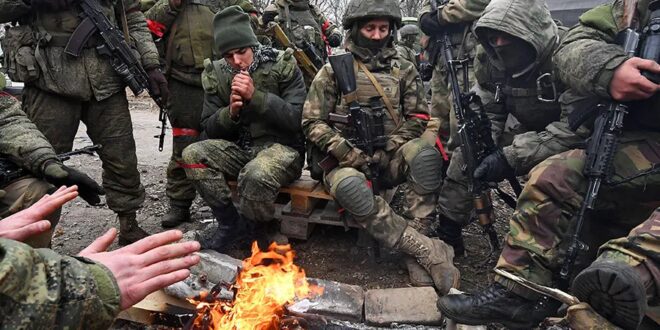Corruption is endemic in Russia and is pervasive within its defence industrial sector and armed forces. Evidence from Ukraine suggests that it is costing Russian lives.
Corruption in the Russian armed forces, and society in general, has been a long-acknowledged truism. The Russian public sector has consistently ranked near the bottom of Transparency.org’s Corruption Perceptions Index, placing 136 out of 180 countries in 2021. Corruption has been perceived as a particular problem within Russia’s military and is seen in some regards as a part of military life. Tor Bukkvoll wrote in a 2005 study of corruption in the Russian armed forces that it included three elements. The first was individual corruption, seen as an essential means of providing a minimal standard of living. The second was institutional corruption, taken to mean the ‘web of informal rules, constraints and habits’ that governed the lives of Russian officers. Finally, there was the political level, which included the relations between the Russian government, the military, and institutions established to police corruption.
Notable cases of Russian corruption gained public attention throughout the 1990s, including the Russian general dismissed for selling UN fuel while deployed to Kosovo, and reports of Russian soldiers deployed to Chechnya selling their weapons to Chechen fighters. The causes then were complaints about conditions: many Russian soldiers lived in dire circumstances with a poor income, and in the case of Chechnya were committed to an uncoordinated fight against a motivated and well-armed opponent. The problem appears to have grown in scope, leading Russia’s chief military prosecutor Sergei Fridinsky to claim in 2011 that corruption through the abuse of state defence orders had taken on ‘cosmic’ proportions. The opening phases of the war in Ukraine show that this malaise has grown and has cost Russian soldiers their health – and in some cases their lives.
Crowdfunded Warfare
Just a few days after the Russian invasion of Ukraine started, several Russian military veterans who are now prominent bloggers wrote posts asking their followers to collect money for the needs of Russian servicemen. They said that soldiers were in urgent need of tourniquets, medical supplies, and night vision devices. Since then, three Russian bloggers have collected millions of roubles and bought and delivered thousands of items for the Russian servicemen fighting in Ukraine. Their posts indicate that Russian soldiers on the frontline struggle to obtain sufficient medical supplies, helmets, radios, backpacks, camouflage nets, sleeping bags, travel mats, and even bulletproof vests. This trend is similar to efforts underway to source equipment for Ukrainian forces, and may shed light on other anomalies in the Russian armed forces. It is common to see operators from the FSB and Special Operations Forces carrying personal weapons with a mixture of foreign equipment, such as the EOTech G33 magnifier and Aimpoint CompM4s sights. It is possible that corruption leads to the siphoning of funds intended for this type of equipment, inducing those Russian troops that are motivated in their outlook to procure it themselves.
As an example of how this impacts units in Ukraine, one blogger shared the following post on 4 April: ‘Brothers, it is necessary to purchase very important things to help our friendly unit. They are currently relocating from the V area (near Kiev)’. They listed a range of equipment, including 18 modern medical kits and rifle sights, as well as ammunition and night vision optics. They also stated a need for unmanned aerial vehicles and body armour.
In a post from 16 April, one of the bloggers mentioned that since the start of the war, volunteers have spent over 60 million roubles ($814,000, or £641,000) on various supplies for the Russian forces. And this, they claim, has not covered even 5% of the requests. They underline that they only take requests from units which are currently operating on the frontline and have been there for a while, exhausting their resources. Bloggers claim they do not help those who have just arrived in the warzone from their bases (who have had a chance to get the needed kit themselves) or those who are just preparing to go.
Recycle, Reuse, Repair
Body armour remains something of a luxury for some forces; China has only recently begun to introduce it into its ground forces on a large scale. Russian troops could be observed in Georgia without any body armour at all, while their opponents carried modern Western designs. Nonetheless, Russia launched the much-vaunted Ratnik programme, designed to introduce common personal equipment across the Russian ground forces, including uniform, personal webbing and body armour. A basic load-out for infantry costs $3,500 per individual, and it has been claimed that 200,000 sets had been delivered by 2017. However, there is evidence that vital elements of the Ratnik system did not reach their intended destination. The Ratnik body armour, known as 6B45, could be bought on Avito (Russia’s eBay) at a cost of $200–250. A full vest with a helmet could be bought for around $300, and a pair of plates for $100–150. ‘All those “Granite” plates that cost 10,000 roubles per pair – they were stolen from warehouses by ensigns and sold online’, wrote one blogger on 6 April.
‘It’s going to be especially bad for those who are mobilised now and may get bullshit instead of a bulletproof vest’, he added. Ukrainian Defence Intelligence reported in mid-April that Russian soldiers arriving in Ukraine had been provided with decommissioned body armour, its fabric rotten and the plates rusted. Like many of the cases discussed here, this is not new for the Russian armed forces. In 2008, a case was opened against the former head of the supply department of the Russian Ministry of Defence, Valery Znakhurko, who was charged with fraud and abuse of power over the procurement of body armour for the army. The body armour had been ordered from a company called Artess and was all found to be unusable by the Main Military Prosecutor’s Office. Body armour is unlikely to shift the course of a war; however, it increases the survivability of infantry formations and can dramatically reduce the number of casualties that a unit suffers. If its absence is widespread throughout the Russian forces, this may contribute to a loss of morale.
Body armour increases the survivability of infantry formations; if its absence is widespread throughout the Russian forces, this may contribute to a loss of moraleThis practice extends to uniforms too. ‘Conscripts often got used uniforms, because the new ones are sold on Avito. They would often get uniforms 1–2 sizes bigger than they needed, because most used sizes are sold out’, said the former officer. The presence of many brand-new uniforms on Avito supports this, and pictures posted by bloggers show that they have delivered boxes of socks, t-shirts and thermals to servicemen in Ukraine. Bloggers are also constantly raising money for ‘proper boots for guys’. In a post from 18 April, one blogger noted that ‘at least 500 pairs of boots are needed’. This validates other claims that Russian troops were not provided with cold weather gear, waterproof clothing, or fuel for their cooking stoves, which made the fighting in March uncomfortable for many. Russian soldiers have also asked for backpacks because the issued ones are inconvenient to carry and are not durable. The same applies to their personal webbing and helmets.
An Army Marches on its Stomach
A video released by Ukrainian soldiers on 1 March shows a captured Russian ration pack; the information on the back reveals an expiration date of 2015. This combined with reports of Russian soldiers going without food for three days seems indicative of the poor state of planning, but may also point to corruption. For example, a Russian citizen called Vyacheslav Zabaluev was sentenced to five years in prison for complicating the supply of rations to Russian troops in the Donetsk and Luhansk republics in December 2021. Zabaluev was alleged to have diverted rations if bribes were not received in time and worked for a company called Voentorg. Voentorg is a primary supplier of catering services for the Russian armed forces, and has subcontracted a company called Main Line with reported links to Evgeny Prigozhin. Prigozhin finances and organises the Wagner mercenary group, and is thought to have links to Russia’s Internet Research Agency, as well as being close to President Vladimir Putin. These reports combined suggest that the institutional and political corruption endemic in Russia may have resulted in suboptimal supplies to Russian troops, both in terms of quantity and quality. Independent investigations by the Russian news outlet Sobesednik indicate that this may have been the case in peacetime as well.
Unsurprisingly, this situation is not new to Russian soldiers. In a private conversation, a veteran officer who insisted on anonymity said, ‘My older colleagues who went to Chechnya told numerous stories of how they had nothing to eat while being sent on combat missions. They just weren’t provided with supplies and food rations. At the same time, the head of the battalion told me how he earned some money selling hundreds of boxes of supplies to locals’.
Weekend Jobs
Other forms of corruption in the Russian Army include the use of conscripts to conduct construction work; examples range from the personal homes of Russian officers to local construction projects. This practice has one major impact, which is on the training of Russian personnel. This already tends to be a mixed situation, as some officers have no interest in training conscripts, and funds and resources are limited because of corruption. The officer explained, ‘During my years of service in the engineer unit, I often saw how suitable military equipment together with personnel was sent to work at civilian construction sites – this was a way for the higher command to earn money. All junior personnel will work for free, and the civilian customer will pay the commander’. This would reduce the time available for training and mean that the soldiers would visit a training range just once or twice a year, he added. This situation is not thought to be ubiquitous; some Russian formations like the Airborne Troops appear to be well-trained, which is reflected in their frequent use. Perhaps the same is true of the artillery, which is relied upon by most of the armed forces to deliver lethal effects.
Life-Saving Essentials
Several Rosgvardia servicemen have said that they were not provided with any medical kits. Army units also receive only very basic personal medical kits, which have not changed since the 1960s. Officially, soldiers are only entitled to one rubber tourniquet, one bandage, a few purifying tablets, and a painkiller. All additional supplies, including modern CAT tourniquets, homeostatic bandages, burn treatments, and chest seals, are bought either by servicemen themselves or by volunteers. Some of the above-mentioned bloggers have posted about deliveries of thousands of modern tourniquets and bandages to troops deploying to the frontline. According to these accounts, deliveries extend beyond the frontlines to rear echelon medical services. They claim to have delivered several boxes of lidocaine, trocars, pleural drains, and IV units.
These reports clash with assertions made in the Russian press, claiming that the military medical institutions in Russia are some of the best in the world and capable of handling up to 1,500 casualties per day in the event of a crisis. Reports from Belarus cite overflowing hospitals filled with Russian casualties, indicating that medical care at the frontlines, and in the rear of Russian positions, is lacking in places.
Can You Hear Me?
Russia’s communication troubles have been evident in places throughout the war. This, too, may be a partial result of corruption, as Russian bloggers are constantly raising money to buy walkie-talkies, radio sets and power supplies for Russian troops. The radio sets referred to are usually Chinese brands such as the Baofeng UV-82. Other more expensive items are found on bloggers’ lists, such as quadcopter drones. The Russian Army is supposedly well-furnished with tactical drones, but servicemen – especially those in reconnaissance and airborne units – claim that mini-drones are essential for the survival of units on the frontline. Some bloggers have already spent millions of roubles buying drones for the Russian Army such as the Mavic Mini 2.
Corruption in the Russian armed forces occurs from the top to the bottom, leading to shortages of skills and equipment, and ultimately reduced performance in combatOn 26 April, a famous Russian blogger, air force veteran and former fighter pilot started raising money to ‘properly equip’ pilots with survival kits. Issued kits are considered to be heavily outdated. Pilots are already buying the majority of medical supplies and GPS units themselves.
‘Now there is a burning issue with communication. Cell phone communication in Ukraine is not available for our fighter pilots. Cell phones are instantly monitored, their signal is blocked, and enemies immediately move to the place from which the signal was sent. The emergency communication radio, which is included in the pilot survival kits, is shit. Using it you can contact someone on just one frequency, which is well-known to everyone. And even then, you can only reach anyone by accident. Therefore, portable radios with aviation range are very much needed. One such radio costs about 40,000 roubles. But they can still be bought’, wrote the former fighter pilot in an address to his followers.
Military aviation units – especially frontline aviation and fighter pilots – are considered among the elite of any army in the world. ‘A frontline aviation pilot of the first class takes on average 7–8 years to prepare, and the cost of his training is about $3.4 million. The training of a sniper pilot takes 10–12 years and costs $7.82 million’, said Commander of the Russian Air Force Alexander Zelin in 2019.
If even fighter pilots are experiencing troubles with supplies and ask for popular support in order to buy the equipment they need, this could be a hint of what is going on in other, less elite and less prioritised branches of the Russian military.
People Corrupt Power
It appears that corruption remains a problem for the Russian armed forces. It occurs from the top to the bottom, leading to shortages of skills and equipment, and ultimately reduced performance in combat. However, it is important to note that this situation may not be universal. There is evidence that some Russian units are better motivated and equipped than others, indicating that corruption has not prevented those units from receiving the equipment necessary to perform their roles. This suggests that future analysis of the Russian military would be well-advised to include further research into the impacts of corruption upon equipment and training levels, so that a body of research can be used to inform assessments of Russian military capabilities.
 Eurasia Press & News
Eurasia Press & News




